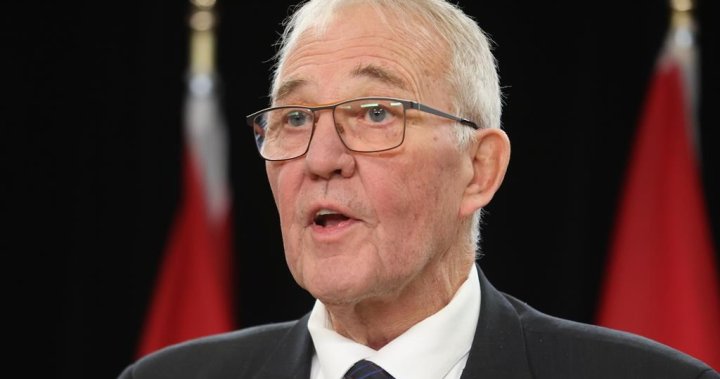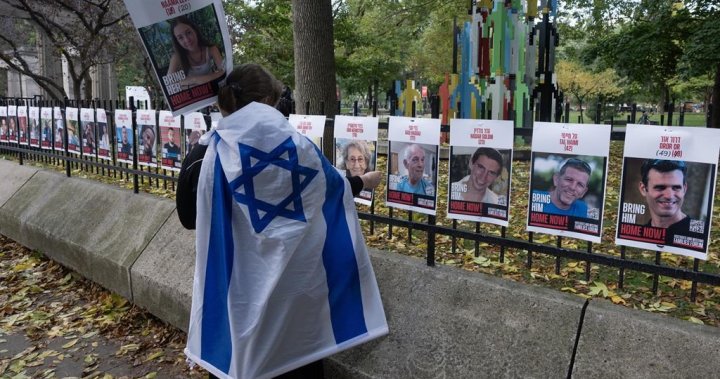The first three hostages scheduled to be released from Gaza have been transferred to Israeli forces, the military announced on Sunday, hours after a fragile ceasefire between Israel and Hamas took effect.
Israeli media, broadcasting live footage from the Qatar-based Al Jazeera channel, showed the hostages walking towards Red Cross vehicles as their convoy moved through Gaza City. The vehicles were accompanied by armed men wearing green Hamas bandanas, struggling to guard the cars from an unruly crowd that numbered in the thousands.
Meanwhile, thousands of people gathered in Tel Aviv to watch the news on big screens, and cheers exploded. For months, many gathered in the square to demand a ceasefire agreement.
The agreement heralds an initial six-week period of calm and raises hopes for the release of dozens of hostages held by militants and an end to the devastating 15-month war. Hamas’ last-minute delay delayed the start of the truce by about three hours and highlighted its fragility.
Story continues below ad
Even before the ceasefire came into effect, celebrations broke out across the region and some Palestinians began returning to their homes. Israel had previously announced the names of the first three hostages to be released in exchange for the scheduled release of 90 Palestinian prisoners later on Sunday.
The truce, which began at 11:15 a.m. local time, is the first step toward eventually ending the conflict and the return of nearly 100 hostages kidnapped by Hamas in the October 7, 2023, attack.
An Israeli official confirmed that Romi Gonen, 24, Emily Damari, 28, and Doron Steinbrecher, 31, were the hostages who were released on Sunday. Gonen was kidnapped from the Nova Music Festival, while the others were kidnapped from Kibbutz Kfar Azza. Al-Damari is a dual Israeli-British citizen.
The official, who spoke on condition of anonymity in line with regulations, said the families had agreed to publish the names.
Meanwhile, between 8:30 a.m. and the ceasefire taking effect, Israeli fire killed at least 26 people, according to the Gaza Ministry of Health. He did not mention whether they were civilians or fighters. The army warned people to stay away from Israeli forces as they withdraw to a buffer zone inside Gaza.
Meanwhile, the hardline Israeli National Security Minister said that the Jewish Power Party he leads is withdrawing from the government in protest against the ceasefire agreement. The departure of Itamar Ben Gvir weakens Israeli Prime Minister Benjamin Netanyahu’s coalition, but will not affect the truce.
Story continues below ad
In a separate development, Israel announced that it had recovered the body of Oron Shaul, the soldier who was killed in the war between Israel and Hamas in 2014, in a special operation in Gaza. The bodies of Shaul and another soldier, Hadar Goldin, remained there after the 2014 war and were not returned.
Fragile agreement
The ceasefire agreement was announced last week after a year of mediation by the United States, Qatar and Egypt. The outgoing Biden administration and President-elect Donald Trump’s team pushed for an agreement before the inauguration on Monday.
Netanyahu warned on Saturday that he has Trump’s support to continue the fight if necessary.
The first phase of the ceasefire, which will last 42 days, is scheduled to witness the return of 33 hostages from Gaza and the release of hundreds of Palestinian prisoners and detainees. Many displaced Palestinians should be able to return to their homes.
There is also supposed to be an increase in humanitarian aid, with hundreds of trucks entering Gaza daily, a much larger number than Israel had previously allowed. The United Nations World Food Program said that trucks began entering through two crossings after the ceasefire took effect.
This is just the second ceasefire in the war, longer and more important than the week-long ceasefire in November 2023, with the potential to end the fighting for good.

Get daily national news
Get the day’s top political, economic and current affairs news, headlines, delivered to your inbox once a day.
Negotiations on the second, more difficult phase of this ceasefire are scheduled to begin in just over two weeks. Big questions remain, including whether the war will resume after the first phase and how the remaining hostages in Gaza will be freed.
Story continues below ad
Palestinians celebrate despite the delay
Across the Gaza Strip, celebrations broke out as people hoped for a respite after the fighting killed tens of thousands, destroyed large areas of the Strip and displaced most of its residents.
Masked gunmen appeared at some celebrations, with crowds chanting slogans in support of them, according to Associated Press correspondents in Gaza. Hamas-run police began deploying in public places after remaining on alert due to Israeli air strikes.
Some families return to their homes on foot, their belongings loaded onto donkey carts.
In the southern city of Rafah, residents returned to find massive destruction. Some found human remains, including skulls, under the rubble.
“It feels like you are watching a Hollywood horror movie,” resident Muhammad Abu Taha told the Associated Press as he inspected the ruins of his family home.
Israelis are divided over the ceasefire agreement
In Israel, people remained divided over the agreement.
Asher Bezim, 35, from the city of Sderot near Gaza, said he was impatiently awaiting the return of the hostages, but said the agreement only led to the postponement of the next confrontation with Hamas. He also criticized Israel for allowing aid into Gaza, saying that this would contribute to the revival of the armed movement.
“They will take their time and attack again,” he said as he overlooked the smoldering ruins of Gaza from a small hill in southern Israel with other Israelis gathered there.
Story continues below ad
The Israeli Cabinet approved a ceasefire early Saturday in a rare session during the Jewish Sabbath, more than two days after the mediators announced the agreement.
Huge toll
The war’s toll has been enormous, and new details about its scope will now emerge. The mayor of Rafah in Gaza, Ahmed Al-Sufi, said that the Israeli army destroyed a large part of the infrastructure, including water, electricity and road networks, in addition to thousands of homes.
More than 46,000 Palestinians have been killed, according to the Gaza Ministry of Health, which says women and children make up more than half of the dead but does not distinguish between civilians and combatants.
The Hamas-led attack on southern Israel that sparked the war killed more than 1,200 people, most of them civilians, and the militants kidnapped about 250 others. More than 100 hostages were released during a week-long ceasefire in November 2023.
About 90% of Gaza’s population has been displaced. The United Nations says homes, the health system, road networks and other vital infrastructure have been severely damaged. Rebuilding – if the ceasefire reaches its final stage – will take at least several years. The big questions regarding Gaza’s future, whether political or otherwise, remain unresolved.
Here’s a look at the three hostages who were released on Sunday:
Rumi Gonen, 24
This undated photo, provided by the Hostage Family Forum, shows Israeli hostage Romi Gonen, held in Gaza by Hamas militants. (Hostage Family Forum via AP) Not supported.
Trending now
-

Prime Minister Danielle Smith will spend 5 days in Washington, D.C., to attend Trump’s inauguration
-

Justin Baldoni is suing Blake Lively and Ryan Reynolds for $400 million
Rumi Gonen was kidnapped from the Nova Music Festival in southern Israel on October 7, 2023. That morning, Gonen’s mother, Merav, and her eldest daughter spent nearly five hours talking to Gonen as gunmen stormed the festival grounds. Junine told her family that roads clogged with abandoned cars made escape impossible and that she would take refuge in some bushes.
Story continues below ad
Then she said words that still echo in her mother’s head every day. “My mother, she was shot, the car, everyone was shot. … I am hurt and bleeding. “Mom, I think I am going to die,” Romi recounted at a press conference a few weeks after the kidnapping.
Confused, Merav Gonen tried to convince her daughter that she would not die, so she could begin breathing and treating her wounded friends. According to Merav, Gonen’s last word during the call was a cry of “Mama!” As the gunfire approached and the screams of the men drowned everything out.
Then hang up the phone. The Israeli authorities located her phone in Gaza.
Over the past 15 months, Merav has been one of the most outspoken voices advocating for the return of hostages, appearing almost daily on Israeli news programs and traveling abroad on missions.
“We are doing everything we can so that the world does not forget it,” Merav told The Associated Press on the six-month anniversary of the Hamas attack. “Every day we wake up and take a big breath, a deep breath, and keep walking, and keep doing the things that will bring you back.”
Emily Damari, 28
This undated photo, provided by the Hostage Family Forum, shows Israeli hostage Emily Damari, held in Gaza by Hamas militants. (Hostage Family Forum via AP) Not supported.
Emily Damari is a British-Israeli national who was kidnapped from her apartment in Kibbutz Kfar Azza, a collective farming village badly damaged by a Hamas attack. She lived in a small apartment in the Al-Shabab neighborhood, the part of the kibbutz closest to Gaza. The gunmen breached the kibbutz’s border fence and looted the neighborhood.
Story continues below ad
Damari’s mother, Mandy, said she loved music, travel, soccer, good food, karaoke and hats. Kibbutz Kfar Azza said Damari was often “the glue holding together her close-knit group of friends” and was always organizing gatherings of friends around the best barbecue corner in the entire kibbutz.
“I hold on to that shred of hope that I still have in my heart that she is alive, despite her suffering,” Mandy Damari said in front of Damari’s burned apartment last January. “I’m desperate, angry, and afraid for her life.”
Doron Steinbrecher, 31
This undated photo provided by the Hostage Family Forum shows Israeli hostage Doron Steinbrecher, who is being held in Gaza by Hamas militants. (Hostage Family Forum via AP) Not supported.
Doron Steinberger, a veterinary nurse who loves animals, is Damari’s neighbor in Kibbutz Kfar Azza.
At 10:20 on October 7, 2023, Steinbrecher called her mother. “Mom, I’m scared,” her brother Dor recalls: “I was hiding under the bed and I heard them trying to get into my apartment.” She managed to send a voice message to her friends. “They got me!” They got me! They arrested me!” in the moments of her kidnapping
Story continues below ad
That letter was key in helping her family understand Doron’s kidnapping.
Steinbrecher appeared in a video published by Hamas on January 26, 2024, along with two other Israeli female soldiers. Her brother said the video gave them hope that she was alive but raised concern because she appeared tired, weak and emaciated.
In total, the militants killed 64 people and 22 soldiers, and kidnapped 19 people from Kibbutz Kfar Azza on October 7. With the return of Steinbrecher and Damari, three kibbutz members remain detained in Gaza: American-Israeli Keith Siegel, 65; and twins Galli and Zev Berman, 27 years old.
With files from Melanie Liedman

















